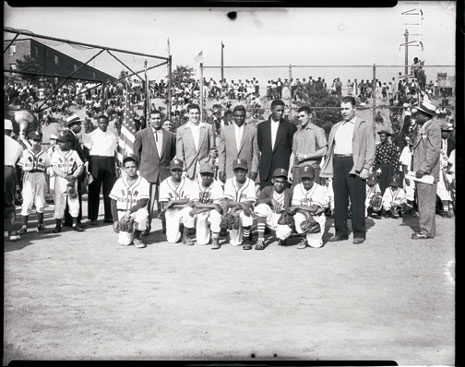Back

Five decades
after the Pittsburgh Courier identified him incorrectly
in this Teenie Harris photo, Sterling
Smith (the 12-year-old Elks baseball player, fourth
from the left in the front row) is finally setting
the record straight thanks to Carnegie Museum of Art’s
efforts to identify and record the history told in
Harris’ photographs.
It’s Opening Day, 1952, at Pittsburgh’s Kennard
Field, and 12-year-old Sterling Smith, second baseman for
the Elks youth baseball team, poses proudly for a group
photo with
his idols, Jackie Robinson, Roy Campanella, and Joe Black.
But the next day, when the Pittsburgh Courier publishes
the shot of the Hill District event, taken by prolific
photographer Charles “Teenie” Harris, the unthinkable
happens: “They called me Stanley in the photo caption!” says
Smith, laughing in mock indignation.
More than 50 years
later, Smith has formally set the record straight. His
small annotation of local history is among
thousands of clues from indi-viduals taking part in identifying
the Teenie Harris photo archive at Carnegie Museum of Art.
The second edition of Documenting Our Past: The Teenie
Harris Archive Project, an exhibition of works from
Harris’ 40-year
career, will be shown in the museum’s Forum Gallery beginning
in early February.
The exhibition will feature a display
of more than 200 digital prints, a collection of more than
5,000 digital
images that will be continuously updated and viewable on
gallery computers, and bound sets of thousands of photocopied
images. In addition, images will be available
on the museum’s web site, where they can be viewed
by cyber-surfers worldwide, exponentially increasing the
chances for an “aha!” moment.
The memories
of thousands of Pittsburghers captured in Harris’ images
are giving context to the gigantic archive, the largest
collection of Pittsburgh images by a single photographer.
The communal nature of the identification project is “a
chance for the common man to take center stage,” says
John Brewer, director of the Trolley Station Oral History
Center in Homewood, one of the sites where the public can
view images to help identify
the people and places captured by Harris decades ago.
Boosting
the wealth of personal anecdotes is the digitization of
the collection. With funding from the National Endowment
for the Humanities, the museum has hired a team of archivists
and technicians who have scanned and filed an additional
5,000 images, at a rate of 150 a day since the first Harris
exhibition in 2003. “We’ve only scratched the
surface,” says photo archivist Kerin Shellenbarger. “We’ve
catalogued 9,000 images of 80,000.”
The quest to
get first-person documentation of photo dates, places,
and participants began with, and still includes,
personal outreach through talks with local seniors groups
and field trips that bring elderly patrons into the museum
to view photocopies of the works. But Internet access has
quickened and broadened the community connection.
The project
team reports that younger people bring their elderly relatives
to home computer screens to view the images on the museum
website. “We get
lots of e-mails that begin, ‘My grandmother says
this photo shows someone or something,’” says
Shellenbarger. “We’ve gotten thousands of responses.”
Electronic Sleuthing
As the whiz of a digital scanner provides a rhythmic downbeat,
Shellenbarger explains
the detective work of documenting photos. “Everything
has grains of information,” she says.
Cataloguer
Celeta Hickman is entering data for a Harris street scene.
The intersection bears a Penn Avenue sign,
so she consults a city directory to estimate when a hotel
and restaurant shown operated at number 3237. She then
notes the exact
dimensions and conditions of the negative. “We get
responses from some regulars, especially jazz and sports
historians,” says Shellenbarger. “And we Google
a lot.”
Connecting a name to a face can sometimes
take years. Shellenbarger had seen the policeman known
as “Big Blue” in
dozens of Harris photos, but it wasn’t until this
year that her team was able to identify him as Prince Bruce,
a longtime patrolman in the Hill District. A 1947 caption
from the Courier provided the link.
Within Pittsburgh’s
black community, says historian Brewer, the identification
process can get “very
emotional.” He recalls a woman in tears, crumpling
to the floor in front of a Harris photo on display at the
Trolley Station. “The photo showed her as a young
child, with her mother and sister sitting in a sparse room,
starving,” he recalls. “She grew up to become
a nuclear physicist in Stockholm.” For African American
Pittsburghers scattered by the Depression and the decline
of the steel mills, Brewer notes, Harris’ photos
provide “a lost connection to family.”
Community
connections have been rediscovered, too. Brewer points
out that, thanks
to Harris’ photographic documentation, Pittsburghers
are reminded that 50 years ago,
the Miller Street Baptist Church was a synagogue serving
Jewish residents of the Hill District. Images like this,
he says, “allow people to connect to the past.” And
now, with the Teenie Harris collection on the Internet,
the images are connecting people all over the world.
To view Teenie Harris images, visit www.images.library.pitt.edu or www.cmoa.org/teenie/info.asp. Use the online form on
the Carnegie Museum of Art site to submit comments on the
photos.
Back
| Top
|